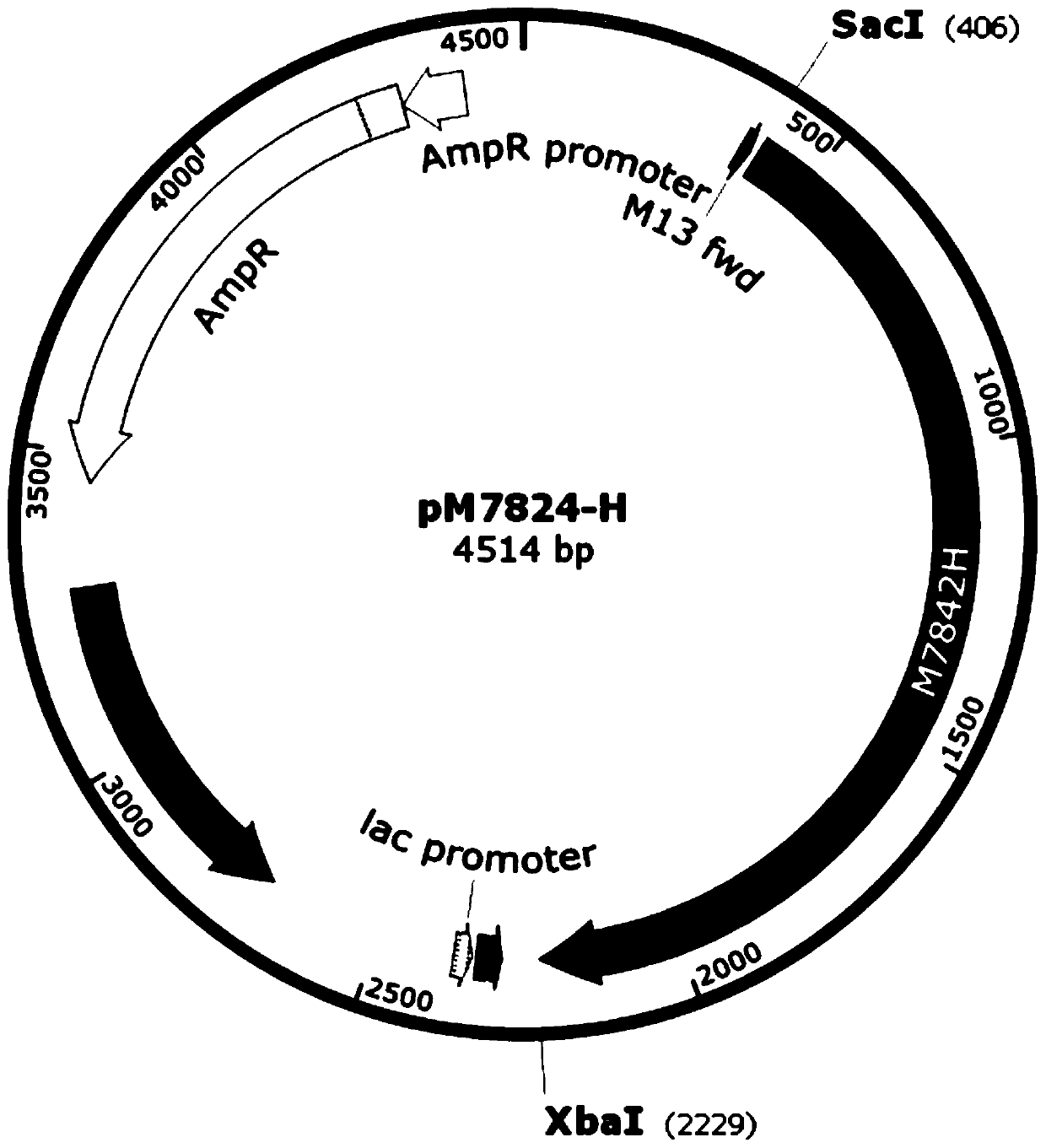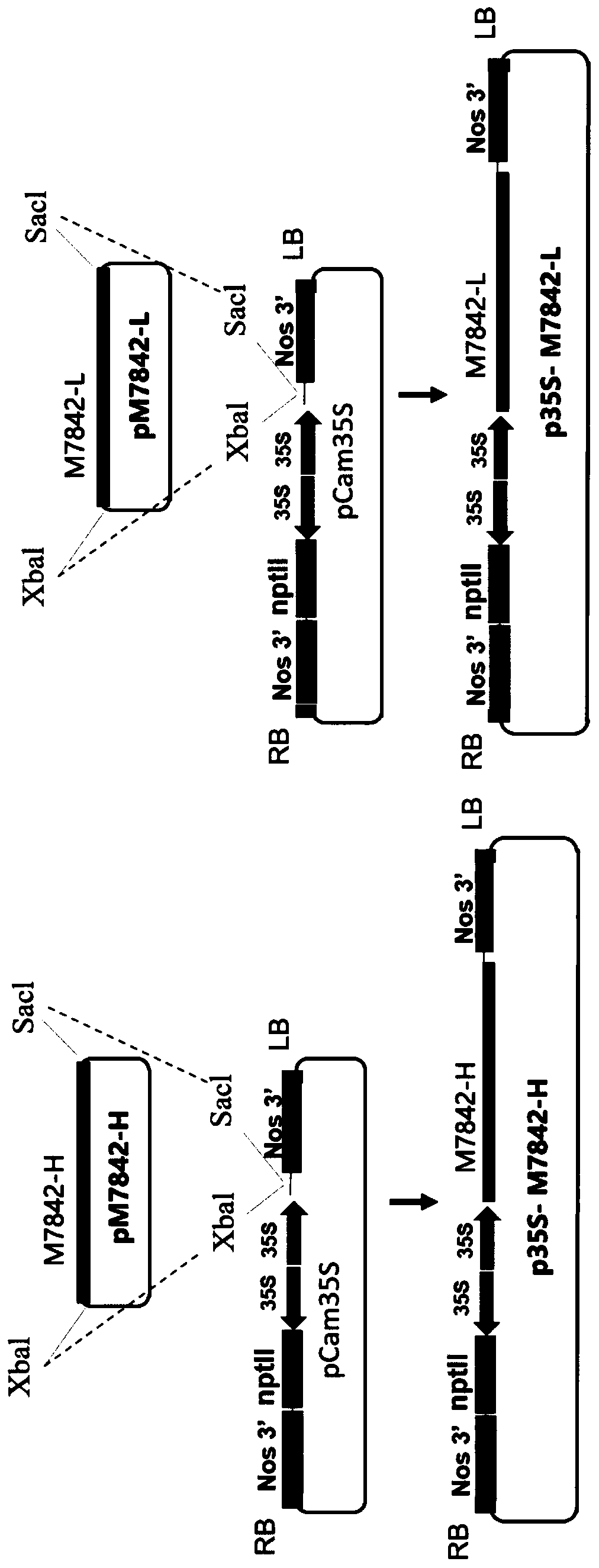Application of plants as host in M7842 expression
A plant and host technology, applied in the direction of microorganisms, animal/human proteins, antibody mimics/scaffolds, etc., can solve problems such as product safety hazards, infection of human diseases and insect pests, time-consuming expression systems, etc., to improve product safety and eliminate Effects of genetic pollution and elimination of potential pests and diseases
- Summary
- Abstract
- Description
- Claims
- Application Information
AI Technical Summary
Problems solved by technology
Method used
Image
Examples
Embodiment 1
[0071] The construction of embodiment 1 plant transient expression vector
[0072]In order to efficiently express foreign proteins in plants, the M7842 heavy chain, light chain, and amino acid sequences were obtained by backtranslation software (https: / / www.ebi.ac.uk / Tools / st / emboss_backtranseq / ) to obtain nucleotides sequence, and its codons were optimized to plant-preferred codons, which were synthesized by GenScript (Nanjing, China). An Xbal restriction site was added to the 5' end of the optimized M7842 heavy chain sequence, and a SacI site was added to the 3' end. Xbal restriction sites were added to the 5' end of the M7842 light chain sequence, and Sacl sites were added to the 3' end. and cloned into the pUC57 vector by GenScript Company to obtain pM7842-H and pM7842-L cloning vectors respectively ( Figure 1A , B), the gene fragments are separated from the cloning vector by Xbal / Sacl respectively, and cloned into the binary plant vector, pCam35S, to produce the plant ...
Embodiment 2
[0073] Example 2 Agrobacterium-mediated vacuum infiltration
[0074] Mix the prepared Agrobacteria containing p35S-M7842-H and p35S-M7842-L in equal amounts until the O.D.600 is 0.5. The culture suspension was placed in a 2L beaker and placed in a desiccator. The lettuce kept in this laboratory was turned upside down (core up) and gently swirled in the bacterial suspension, and the desiccator was sealed. The vacuum pump (Welch Vacuum, Niles, IL, USA) was turned on to evacuate and the permeate was seen in the leaf tissue. Hold the pressure for 30-60 seconds. The system is quickly opened to release the pressure and allow permeate to seep into the spaces within the tissue. This process was repeated 2 to 3 times until the penetration of the permeate into the lettuce tissue was clearly visible. The lettuce tissue was then gently removed from the permeate and rinsed three times consecutively with distilled water before being transferred to a container covered with plastic film. ...
Embodiment 3
[0075] Example 3 Protein Extraction and Separation
[0076] Lettuce samples vacuum-infiltrated by Agrobacterium were stirred with a stirrer, and homogenized at high speed in a blender with extraction buffer (100mM KPi, pH7.8; 5mM EDTA; 10mM β-mercaptoethanol) at a ratio of 1:1 by volume for 1-2 minute. The homogenate was adjusted to pH 8.0, filtered through gauze, and the filtrate was centrifuged at 10,000 g for 15 minutes at 4°C to remove cell debris. The supernatant was collected, mixed with ammonium sulfate (50%), and incubated with shaking on ice for 60 minutes. Centrifuge again (10,000g) for 15 minutes at 4°C. The obtained supernatant was subjected to a second round of ammonium sulfate (70%) precipitation, suspended by shaking on ice for 60 minutes, and centrifuged again at 10,000 g at 4°C for 15 minutes. Then, the supernatant was discarded, and the protein precipitated from the treated samples was dissolved in 5 mL of buffer (20 mM KPi, pH 7.8; 2 mM EDTA; 10 mM β-merc...
PUM
| Property | Measurement | Unit |
|---|---|---|
| Molecular weight | aaaaa | aaaaa |
Abstract
Description
Claims
Application Information
 Login to View More
Login to View More - R&D
- Intellectual Property
- Life Sciences
- Materials
- Tech Scout
- Unparalleled Data Quality
- Higher Quality Content
- 60% Fewer Hallucinations
Browse by: Latest US Patents, China's latest patents, Technical Efficacy Thesaurus, Application Domain, Technology Topic, Popular Technical Reports.
© 2025 PatSnap. All rights reserved.Legal|Privacy policy|Modern Slavery Act Transparency Statement|Sitemap|About US| Contact US: help@patsnap.com



